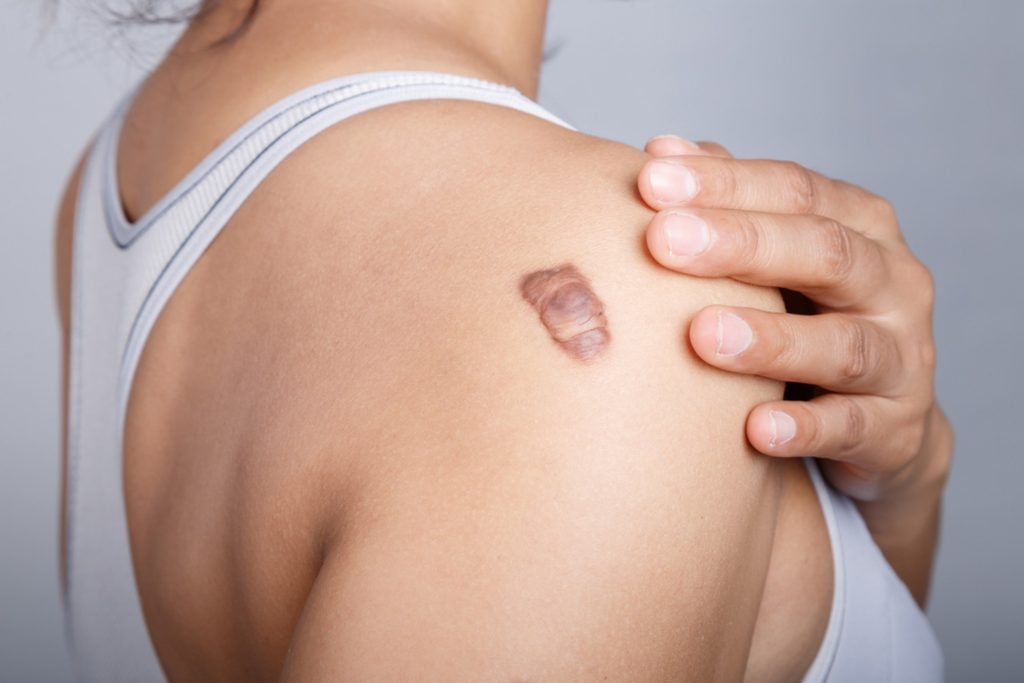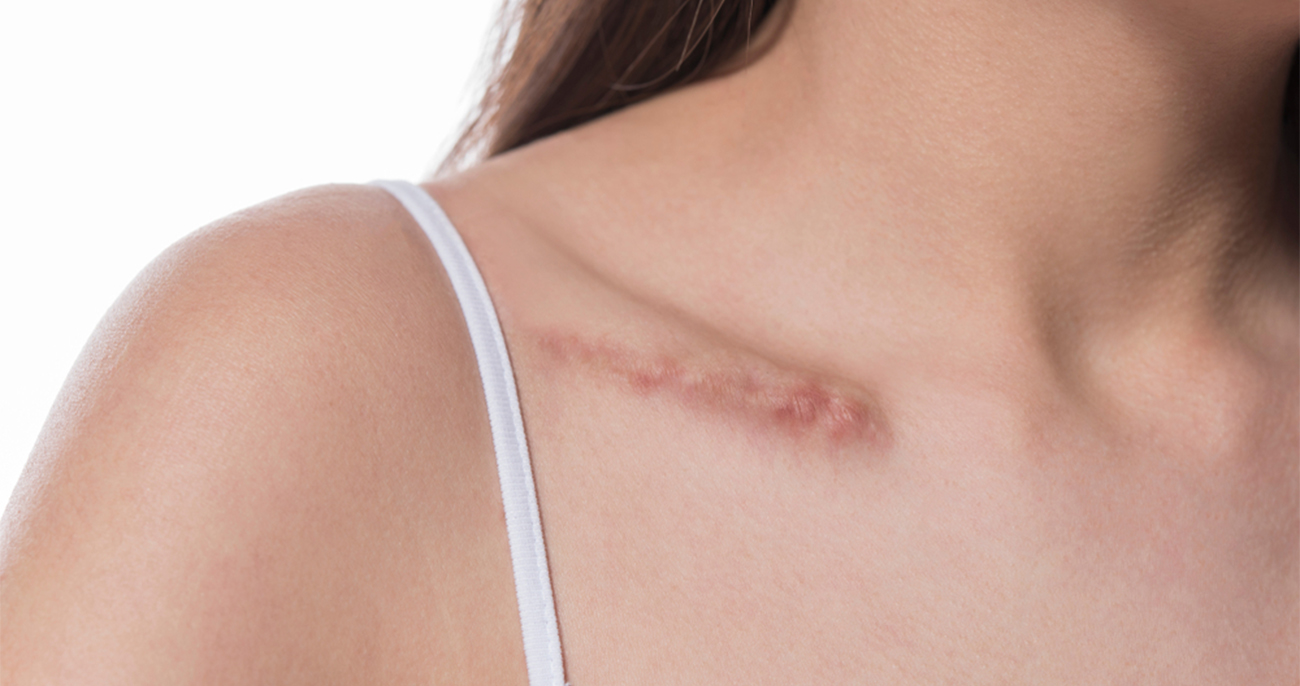Keloid / Hypertrophic / Atrophic
Scars occur as a result of the skin’s normal healing process after it has been damaged by infection or injury. Most superficial wounds heal without scarring. It’s when the deeper layer of skin is damaged that scars form on the skin.
Keloid Scar

Hypertrophic Scar
Keloid scars are unsightly and can affect the quality of life. Keloids are more than just disfiguring cosmetically, many are also itchy and painful.
Keloid scar occurs due to the excessive healing response to an injury on the skin. When the skin heals collagen is formed but in keloid scar the formation of collagen is uncontrolled. This results in extra scar tissue that occurs where the skin has healed. A keloid scar appears as enlarged, raised scar that can be pink, red, skin coloured or darker than the surrounding skin. They differ from Hypertrophic Scars in that in keloid the scar tissue extends beyond the margin of the healed wound. In hypertrophic scar, the scar tissue remains within the boundaries of the healed wound. They occur not necessarily from surgical wounds. They can occur
after minor damage to the skin as in acne spot on jawline, chest or back, after skin piercing, They do not spontaneously regress, often continuing to grow over time.
Younger people between the ages of 10-30 are more likely to develop keloid scars.
Causes Of Keloid Or Hypertrophic Scars
Any kind of trauma that affects the dermis
- Nodular, Cystic acne
- Piercing: earlobes
- Surgery: Any surgical wounds have the potential to become either keloid or hypertrophic scar depending on the individual’s susceptibility. Commonly seen with caesarian sections which is the most common operation done
Treatments for Keloid and Hypertrophic Scars
Keloid Scars are very difficult to treat. Best results are when treated early days of scar appearance. Treatments help to flatten, reduce itch, and improve the colour of the scar.
- Steroid Injections
- Triamcinolone acetonide which is a form of steroid is the most effective treatment for both hypertrophic and keloid scars Steroids have both direct anti-inflammatory and vasoconstrictive effects which results in whitening of the keloid scars. It also breaks the bonds between collagen fibres, which gradually reduces the amount of scar tissue.In the clinic, we combine triamcinolone with botulinum toxin as studies have shown faster and better results.Anaesthetic cream is applied for 20 minutes before the injection is done. There will be some pain and swelling post-procedure which resolves the next day. Improvement of a scar is seen after 3-4 weeks.An injection into scar is done every 3-4 weeks continuously till optimal flattening of the scar occurs.Potential side effects of steroid injections into the skin are depression or hypopigmentation of skin at the site of injection. These side effects are rare and occurrence are minimised by controlling the amount of steroids and frequency of injections.
- Laser Genesis
- Laser genesis is non-invasive, non-ablative treatment that reduces the redness associated with the scars. Usually done before steroid injections.
- Surgery
- Surgery is an option where the scar is well-formed and resistant to steroid injection or affects a large area of skin. To prevent recurrence of keloid or hypertrophic scars, after excision, silicone sheets, scar gel are used and regular weekly injections of steroid are done.
How You Can Prevent Keloid or Hypertrophic Scars?
- If you discover that you have a tendency for keloid scar after the occurrence of first keloid scar, avoid any deliberate injuries to the skin such as ear lobe piercings and tattoos. If you are seeking aesthetic or surgical procedures that involve trauma to the skin you must form the doctor of tendency for keloid scar
- Treat acne as early as possible to reduce likelihood of scars. If you are prone to nodular cystic acne and keloid , best solution is to be treated with Isotretinoin to stop more pimples and stop more scars.
- Don’t squeeze, pop or pick om pimples. In doing so infection is spread to surrounding tissue and worsening of inflammation.
- If you get a large, deep, very inflamed painful breakout get an appointment for immediate treatment, as such lesions are highly likely to leave a bad scar.
- Don’t pick at scabs. A scab protects the wound as it heals. Picking the scab before it heals completely prolongs healing process and increases the chance of scarring.
- Avoid minor skin surgery that is not compulsory to areas on body that are more prone to keloid scarring such as the chest, back and upper arms.
- If you have to have a surgical procedure, use scar gel to ensure good healing of wound. If prone to hypertrophic or keloid scar add silicone gel sheeting 10-14 days after surgery when wound has completely healed. This will prevent occurrence of hypertrophic or keloid scar.
- If the wound is seen to be getting lumpy, red, itchy or painful best to come in for consultation immediately as treatment with steroid injection may be required. Early treatment is imperative for good results
Seek early treatment for infected wounds to minimise damage to the skin
Atrophic scar

Atrophic scar present with indentation over the area of the wound. Due to severe damage to skin, collagen is lost in area of injury or inflammation Most common atrophic scars are acne scars. Other causes of atrophic scars are chicken pox and surgery.
Treatments for Atrophic Scars
Treatments aim to fill up indentation, stimulate collagen production and improve texture of skin. Since most atrophic scars are acne scars , treatments of acne scars are used also for treatment of atrophic scars. Read more
Normotrophic Scar
Normotrophic scar heals normally. However, a scar is still seen. There are treatments to improve the appearance of the scar.
Treatments for Normotrophic Scar
- Laser Treatment: To get rid of the redness that makes the scar obvious. Read more
- Chemical peels: Exfoliation through chemical peels does both improvements of colour and texture of the scar. The skin is resurfaced till scar is hardly visible. Read more
- Polynucleotide S: PN S expedites healing which results in minimal scar formation. Read more




